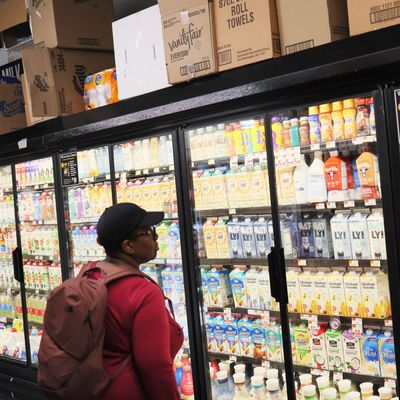
Finally. On Tuesday, the Labor Department reported that the state of inflation in the U.S. is the best it has been since March 2021, with the consumer price index, its gauge of price increases, rising 4 percent in May for the year. Inflation has been falling on an annualized basis for nearly a year now, driven down in large part because the Federal Reserve has been jacking up interest rates in a deliberate attempt to slow the economy. But while previous reports have come with significant caveats, the May CPI report is one of a sunnier overall character, in which the worst parts can be ignored or just really aren’t that bad. Next month is likely to be even better. This won’t last forever, but the time to feel bad about the economy is over.
Any inflation report is just a snapshot of the economy, and this one is showing that, for now, much of the volatility has smoothed out. Some of this has to do with the quirks of how inflation is measured — by now, the CPI index has already phased out nearly every month of 2021 when inflation was increasing in any meaningful way. It’s not that prices aren’t rising anymore; it’s that when costs go up, they’re starting to become more manageable. The cost of food for the month was practically flat, a little higher for restaurant prices. Energy costs — including gas, electricity, and heating — all fell sharply. For most people, this is the heart of what matters in being able to afford things: eating, utilities, going out.
And then there’s the cost of actually living somewhere — a mortgage or rent. During the past year, it rose 8 percent, making it the biggest reason this month’s report is still as high as it is. This has caused the so-called “core” inflation index — which takes out volatile food and energy costs — to increase by 0.4 percent for the month, versus just 0.1 percent for the broader measure. But the key thing to keep in mind about that data point is that it’s out of step with what’s happening today. (This has to do with technical reasons around how the core figure is calculated, which basically weighs housing costs heavily in a backward-looking way.) Instead, take a look at Redfin’s real-time report, which shows a one percent decrease in rent prices during the past year.
Overall, this report feels like a relief. For the past two years, we have faced a consumer landscape of constantly rising grocery bills, skyrocketing gas prices, and landlords jacking up rent with impunity. The reasons were all over the place: companies taking advantage of consumers, Russia’s war in Ukraine, even a surprise chicken influenza.
Besides the practical stresses and difficulties, one jarring thing about it was that it undermined our collective feeling of stability that had come with low inflation for the past 40 years. The new sense of instability became part of the story of the vibecession — the feeling that things were bad, damn the data saying otherwise. But the story of the overall economy has been so cheery in recent months that Mark Zandi, chief economist at Moody’s Financial Services, predicted there won’t be a recession anytime soon.
The other reason this report matters is that it will play a large part in what the decision-makers at the Fed do as they decide how high interest rates need to go. There is no perfect formula for how high the rates can be. Jack them up too high and the economy breaks, businesses lay people off en masse, and a recession sets in. Keep it too low and inflation keeps roaring, nobody can afford anything, and a malaise weighs on consumers. On Wednesday, the Fed is expected to pause its recent spate of ten consecutive rate hikes, a campaign that made interest more than 7 percent for mortgages and almost 25 percent for credit cards. (It also wrecked a handful of banks, which, in turn, tightened up lending standards and had its own disinflationary effect). Last month, when I spoke to Federal Reserve Bank of Minneapolis CEO Neel Kashkari, he was adamant that the central would keep raising interest rates if it needed to and that it was unlikely to cut rates this year. However, he also said a rapid fall, “well on its way down to 2 percent,” could cause the Fed to bring interest costs lower. The Cleveland Fed, which has its own real-time inflation monitor, predicts that next month’s inflation report could drop to 3.2 percent.
It’s likely that when the Fed meets on Wednesday it will keep rates steady for the month. After that, who knows what it will do? One thing driving the central bank’s decisions is Fed chair Jerome Powell’s focus on how much money people make. In short, he thinks people are making too much money, and he would like to see wage growth slow down. And that is what’s happening. Not only has the unemployment rate risen to 3.7 percent but wages are slowing when you factor in inflation. (A separate report released by the Labor Department showed the decrease in real wages has more to do with people working fewer hours than making less per hour.) One of Powell’s preferred ways of measuring inflation — which looks at the service industry without costs related to the housing sector — fell to 3 percent. At this point, it looks like the problems with inflation are largely in the past. The challenge for the Fed now is trying to keep the economy going like this for as long as possible.






























